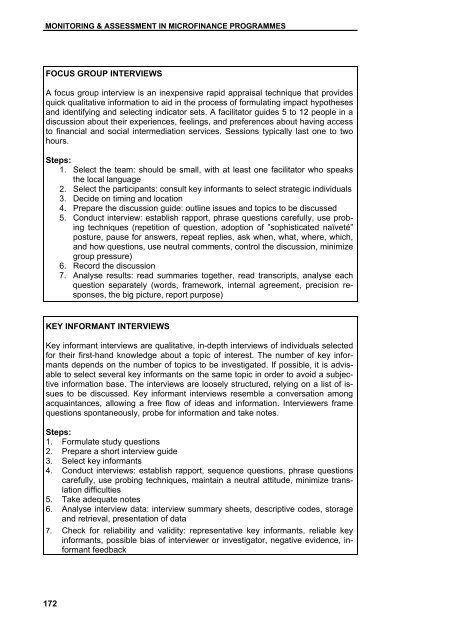Guidelines for Impact Monitoring & Assessment in Microfinance ...
Guidelines for Impact Monitoring & Assessment in Microfinance ...
Guidelines for Impact Monitoring & Assessment in Microfinance ...
Create successful ePaper yourself
Turn your PDF publications into a flip-book with our unique Google optimized e-Paper software.
MONITORING & ASSESSMENT IN MICROFINANCE PROGRAMMES<br />
FOCUS GROUP INTERVIEWS<br />
A focus group <strong>in</strong>terview is an <strong>in</strong>expensive rapid appraisal technique that provides<br />
quick qualitative <strong>in</strong><strong>for</strong>mation to aid <strong>in</strong> the process of <strong>for</strong>mulat<strong>in</strong>g impact hypotheses<br />
and identify<strong>in</strong>g and select<strong>in</strong>g <strong>in</strong>dicator sets. A facilitator guides 5 to 12 people <strong>in</strong> a<br />
discussion about their experiences, feel<strong>in</strong>gs, and preferences about hav<strong>in</strong>g access<br />
to f<strong>in</strong>ancial and social <strong>in</strong>termediation services. Sessions typically last one to two<br />
hours.<br />
Steps:<br />
1. Select the team: should be small, with at least one facilitator who speaks<br />
the local language<br />
2. Select the participants: consult key <strong>in</strong><strong>for</strong>mants to select strategic <strong>in</strong>dividuals<br />
3. Decide on tim<strong>in</strong>g and location<br />
4. Prepare the discussion guide: outl<strong>in</strong>e issues and topics to be discussed<br />
5. Conduct <strong>in</strong>terview: establish rapport, phrase questions carefully, use prob<strong>in</strong>g<br />
techniques (repetition of question, adoption of ”sophisticated naïveté”<br />
posture, pause <strong>for</strong> answers, repeat replies, ask when, what, where, which,<br />
and how questions, use neutral comments, control the discussion, m<strong>in</strong>imize<br />
group pressure)<br />
6. Record the discussion<br />
7. Analyse results: read summaries together, read transcripts, analyse each<br />
question separately (words, framework, <strong>in</strong>ternal agreement, precision responses,<br />
the big picture, report purpose)<br />
KEY INFORMANT INTERVIEWS<br />
Key <strong>in</strong><strong>for</strong>mant <strong>in</strong>terviews are qualitative, <strong>in</strong>-depth <strong>in</strong>terviews of <strong>in</strong>dividuals selected<br />
<strong>for</strong> their first-hand knowledge about a topic of <strong>in</strong>terest. The number of key <strong>in</strong><strong>for</strong>mants<br />
depends on the number of topics to be <strong>in</strong>vestigated. If possible, it is advisable<br />
to select several key <strong>in</strong><strong>for</strong>mants on the same topic <strong>in</strong> order to avoid a subjective<br />
<strong>in</strong><strong>for</strong>mation base. The <strong>in</strong>terviews are loosely structured, rely<strong>in</strong>g on a list of issues<br />
to be discussed. Key <strong>in</strong><strong>for</strong>mant <strong>in</strong>terviews resemble a conversation among<br />
acqua<strong>in</strong>tances, allow<strong>in</strong>g a free flow of ideas and <strong>in</strong><strong>for</strong>mation. Interviewers frame<br />
questions spontaneously, probe <strong>for</strong> <strong>in</strong><strong>for</strong>mation and take notes.<br />
Steps:<br />
1. Formulate study questions<br />
2. Prepare a short <strong>in</strong>terview guide<br />
3. Select key <strong>in</strong><strong>for</strong>mants<br />
4. Conduct <strong>in</strong>terviews: establish rapport, sequence questions, phrase questions<br />
carefully, use prob<strong>in</strong>g techniques, ma<strong>in</strong>ta<strong>in</strong> a neutral attitude, m<strong>in</strong>imize translation<br />
difficulties<br />
5. Take adequate notes<br />
6. Analyse <strong>in</strong>terview data: <strong>in</strong>terview summary sheets, descriptive codes, storage<br />
and retrieval, presentation of data<br />
7. Check <strong>for</strong> reliability and validity: representative key <strong>in</strong><strong>for</strong>mants, reliable key<br />
<strong>in</strong><strong>for</strong>mants, possible bias of <strong>in</strong>terviewer or <strong>in</strong>vestigator, negative evidence, <strong>in</strong><strong>for</strong>mant<br />
feedback<br />
172

















![CynefinFramework final [Read-Only]](https://img.yumpu.com/19017304/1/190x135/cynefinframework-final-read-only.jpg?quality=85)